Employment barriers for people with disabilities represent systemic challenges that persist despite federal protections under the Americans with Disabilities Act (ADA). These barriers range from physical workplace accessibility issues to attitudinal discrimination during hiring and advancement. Understanding ADA compliance requirements and implementing reasonable accommodations helps employers avoid legal liability. It also unlocks access to a talented workforce of over 42 million Americans with disabilities who face unemployment rates nearly double that of their non-disabled peers.
Key Takeaways
- The ADA prohibits employment discrimination against qualified individuals with disabilities and requires employers with 15+ employees to provide reasonable accommodations unless doing so causes undue hardship.
- Physical barriers such as inaccessible facilities, lack of assistive technology, and inadequate transportation options prevent millions of disabled workers from accessing employment opportunities.
- Attitudinal barriers including unconscious bias, stereotyping, and misconceptions about productivity create significant obstacles during recruitment, hiring, and career advancement.
- Reasonable accommodations like flexible schedules, modified equipment, remote work options, and restructured job duties cost employers $500 or less in 56% of cases.
- ADA-compliant employment screening requires limiting background checks and medical inquiries to post-offer stages and ensuring job requirements are truly essential functions.
- Communication barriers affect deaf, hard of hearing, blind, and speech-impaired workers who need accommodations like interpreters, captioning services, and accessible digital platforms.
- Policy barriers such as inflexible leave policies, rigid scheduling requirements, and outdated attendance systems disproportionately exclude workers with chronic conditions and episodic disabilities.
- Employers can reduce disability hiring discrimination by implementing structured interviews, skills-based assessments, and disability confidence training for hiring managers and HR teams.
- The employment rate for working-age adults with disabilities reached 22.5% in 2024, significantly lower than the 65.8% rate for people without disabilities, highlighting persistent systemic barriers.
Understanding Employment Barriers for People with Disabilities
Employment barriers disabilities encompass complex challenges preventing qualified individuals with disabilities from obtaining, maintaining, and advancing in jobs. These obstacles span physical workplace environments, organizational policies, technological systems, and social attitudes. Over 42 million working-age Americans with disabilities continue experiencing unemployment rates consistently higher than the general population.
The Americans with Disabilities Act of 1990, amended in 2008, established protections to eliminate disability hiring discrimination. Despite this legislation, only 22.5% of people with disabilities are employed compared to 65.8% without disabilities as of 2024. Understanding these barriers is essential for employers seeking ADA compliance employment screening practices and building inclusive workplaces.
Disability employment barriers solutions require systematic approaches addressing legal compliance, organizational culture, physical infrastructure, and operational flexibility. Research demonstrates that inclusive hiring practices benefit businesses through increased innovation, improved retention, enhanced reputation, and access to diverse perspectives driving competitive advantage.
Physical and Accessibility Barriers
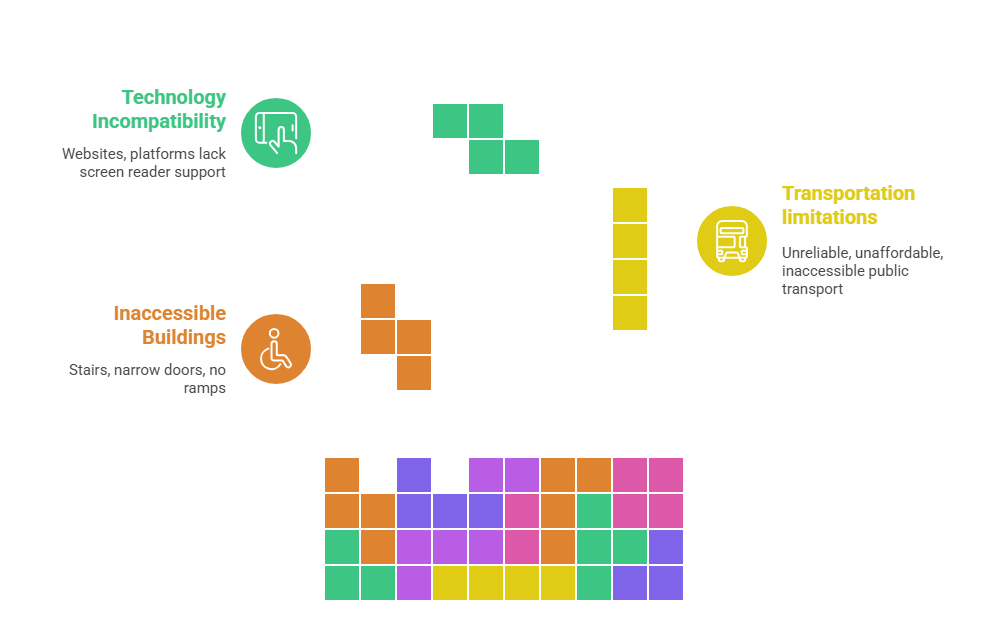
Physical accessibility remains one of the most visible employment barriers facing workers with disabilities. Inaccessible buildings with stairs but no ramps create immediate obstacles. Narrow doorways and restrooms lacking adaptive fixtures present significant challenges. Even when buildings meet basic codes, workstations may lack adjustable desks, ergonomic equipment, or adequate space for mobility devices.
Transportation accessibility extends beyond the workplace to the journey to work. Many workers lack access to reliable, affordable, accessible public transportation, particularly in suburban and rural areas. Parking accommodations including designated accessible spaces near entrances are critical infrastructure employers must provide. For individuals with visual impairments, poorly marked pathways, inadequate lighting, and absence of tactile guidance systems create navigation challenges.
Technology accessibility has become crucial as workplaces digitize operations. Websites, applicant tracking systems, and internal platforms lacking screen reader compatibility create digital barriers. Video conferencing without captioning and document systems not supporting accessible formats contribute to exclusion. Employers committed to reasonable accommodations employment must audit technology ecosystems and invest in accessible alternatives.
Attitudinal and Social Barriers
Attitudinal barriers represent damaging yet invisible obstacles to disability employment. Unconscious bias among hiring managers manifests in assumptions that workers with disabilities will be less productive or require excessive supervision. These misconceptions persist despite research showing employees with disabilities have comparable performance ratings, lower turnover, and equal safety records.
"Disability employment stigma" affects workers across all career stages. During interviews, candidates face inappropriate questions about conditions and accommodation needs before offers. Once employed, they may encounter low expectations, exclusion from projects, or reluctance from colleagues. These dynamics create hostile environments driving talented individuals from positions.
Fear of disclosure prevents many with non-visible disabilities from requesting necessary accommodations. Concerns about being perceived as demanding or experiencing retaliation lead employees to struggle without support. Progressive employers address these barriers through disability confidence training programs educating staff about etiquette, processes, and business value. Creating cultures where disclosure is safe normalizes accommodations.
Policy and Systemic Barriers
Organizational policies designed without disability consideration create systemic employment barriers excluding qualified workers. Rigid attendance policies penalizing absences without accounting for medical appointments disproportionately impact employees with disabilities. Inflexible scheduling prohibiting remote work or modified shifts creates unnecessary obstacles. Many barriers persist due to outdated philosophies prioritizing physical presence over productivity.
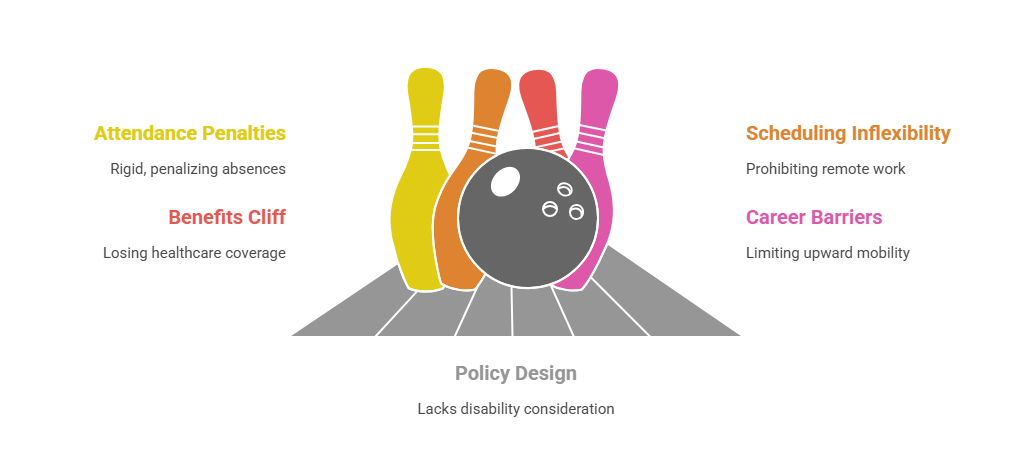
Benefits structures can inadvertently discourage workforce participation. The "benefits cliff" occurs when individuals receiving SSDI or SSI risk losing healthcare coverage if earnings exceed modest thresholds. While Ticket to Work programs exist, many remain unaware. Excessive reliance on temporary or gig employment denies workers access to employer-sponsored insurance and paid leave essential for managing conditions.
Career advancement policies contain hidden barriers limiting upward mobility. Leadership programs requiring extensive travel may exclude individuals with mobility limitations. Promotion criteria emphasizing subjective interpersonal skills may mask disability bias. Performance systems failing to account for accommodations can systematically underrate capable employees. Organizations must examine advancement frameworks ensuring equal access to development opportunities.
ADA Employment Barriers and Legal Protections
The Americans with Disabilities Act provides comprehensive protections against disability hiring discrimination for qualified individuals. Under Title I, employers with 15+ employees cannot discriminate in recruitment, hiring, promotion, training, pay, or termination. A qualified individual can perform essential functions with or without reasonable accommodation. Essential functions are fundamental job duties, not marginal tasks.
Pre-Employment Inquiry Requirements
ADA compliance employment screening requires careful attention to timing and scope. Pre-offer limitations prohibit asking about disabilities, medical conditions, or accommodation needs during applications or interviews. Questions must focus on ability to perform specific job functions. Employers can describe tasks and ask whether candidates can perform them, but not how.
After extending conditional offers but before employment begins, employers may conduct medical examinations or ask health-related questions if all entering employees in that job category undergo the same process. Post-hire inquiries must be job-related and triggered by performance or safety concerns. Documentation of inquiry necessity helps demonstrate compliance if challenged.
Reasonable Accommodation Obligations
Reasonable accommodations employment obligations form the ADA core. These are modifications enabling qualified individuals to enjoy equal opportunities. The interactive process requires good-faith dialogue with employees requesting accommodations to identify solutions. Dialogue should begin promptly and continue until appropriate accommodations are implemented.
Common accommodations include modified schedules, telework, reassignment to vacant positions, assistive equipment, job restructuring, and providing interpreters. Employers can deny accommodations only by demonstrating undue hardship—significant difficulty or expense relative to size, resources, and operations. Understanding undue hardship requires individualized assessment. Factors include accommodation cost, financial resources, and operational impact.
| Accommodation Type | Examples | Average Cost |
| Schedule Modifications | Flexible hours, part-time arrangements, additional breaks | $0 |
| Workspace Adjustments | Ergonomic furniture, desk raisers, improved lighting | $500 |
| Assistive Technology | Screen readers, voice recognition software, amplified phones | $1,200 |
| Policy Modifications | Telework options, service animal permissions, modified dress codes | $0 |
Communication and Information Barriers
Communication barriers significantly impact job access for workers with hearing, vision, speech, and cognitive disabilities. Deaf and hard of hearing employees encounter workplaces unprepared to provide essential support. Meetings without captioning or interpreters exclude workers from information sharing. Phone-centric systems, uncaptioned video, and audio-only notifications create obstacles easily addressed through technology.
Workers with vision impairments face barriers when employers rely exclusively on visual communication. Printed materials without accessible alternatives create obstacles. Presentations using visual-only elements without verbal descriptions present challenges. Signage lacking Braille limits participation. Digital systems lacking screen reader compatibility multiply challenges. Progressive employers implement universal design principles including advance agendas, high-contrast text, and accurate captions.
Cognitive and Learning Disabilities
Individuals with cognitive disabilities, learning disabilities, and neurodivergent conditions including autism and ADHD encounter barriers related to information processing and sensory environments. Dense documents without visual summaries present obstacles. Rapid verbal instructions without written follow-up create confusion. Noisy open offices significantly impair performance. Simple accommodations like multiple format instructions, noise-canceling headphones, and quiet workspaces enable full capability demonstration.
Communication technology advances have expanded accommodation options. Real-time captioning, video relay interpretation, text-to-speech applications, and speech-generating devices enable full participation. Many technologies integrate seamlessly with existing platforms at minimal cost. Employers investing in accessible communication infrastructure reduce barriers while improving overall effectiveness.
Reasonable Accommodations: Practical Solutions

Implementing effective reasonable accommodations employment practices requires understanding that solutions must be individualized based on specific job functions and disability-related limitations. The interactive process begins when employees disclose disabilities and request accommodations. Employers should respond promptly, asking clarifying questions about limitations rather than probing diagnoses. Medical documentation may be requested when disability or accommodation need isn't obvious.
Cost-effective accommodations are common. Job Accommodation Network research shows 56% cost nothing, while typical expenditure is only $500. Low-cost accommodations include schedule flexibility for medical appointments, remote work permission, written instructions supplementing verbal communications, and periodic rest breaks. These modifications rarely impose operational burdens while improving productivity and retention.
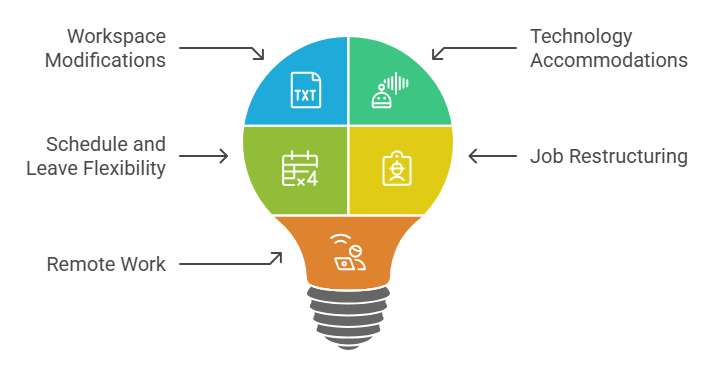
- Workspace Modifications: Adjustable desks, ergonomic keyboards, footrests, document holders, specialized seating
- Technology Accommodations: Screen magnification software, alternative keyboards, voice recognition software, adapted mouse devices
- Schedule and Leave Flexibility: Modified schedules for fatigue or treatments, additional unpaid leave, part-time arrangements
- Job Restructuring: Reassigning marginal functions, exchanging tasks, eliminating non-essential duties
- Remote Work: Telework arrangements eliminating commuting barriers and reducing environmental triggers
Documentation and tracking help demonstrate ADA compliance and identify accommodation trends suggesting workplace-wide improvements. Confidentiality is legally required, with details shared only on a need-to-know basis. Regular check-ins ensure effectiveness and allow adjustments as duties or limitations evolve.
Creating Inclusive Hiring Practices
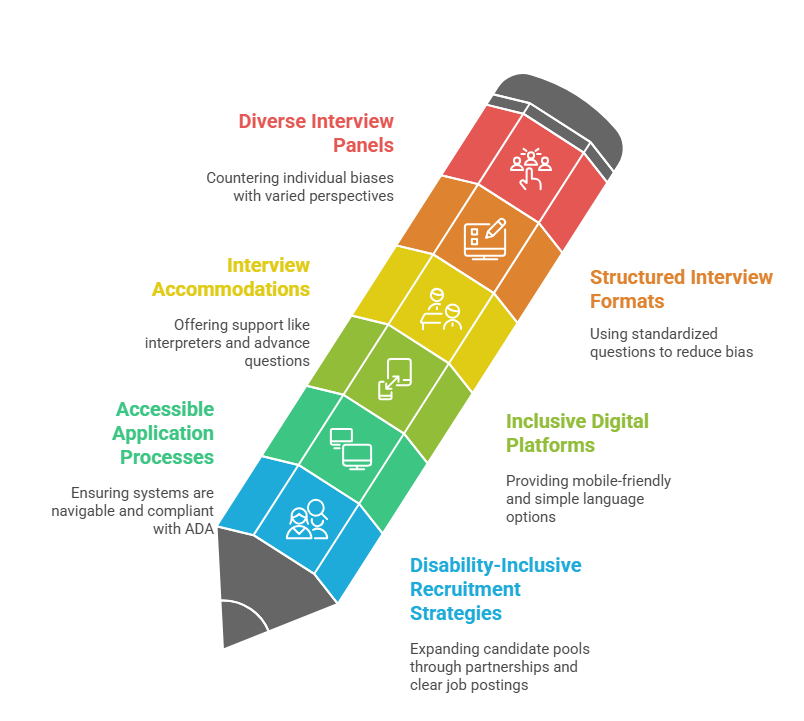
Disability-inclusive recruitment strategies actively expand candidate pools beyond traditional channels that may exclude qualified applicants. Partnering with disability-focused organizations like state vocational rehabilitation agencies helps connect with pre-screened candidates. Job postings should explicitly state commitment to diversity and mention accommodation availability.
Accessible Application Processes
Application processes can contain hidden barriers. Online systems lacking keyboard navigation exclude candidates. Those imposing arbitrary time limits or requiring mouse-only interactions create barriers. Forms requesting disability disclosure before offers violate ADA compliance. Progressive employers provide multiple application channels including email and phone alternatives, allowing reasonable time extensions.
Accessible digital platforms benefit all applicants. Mobile-friendly applications accommodate various access preferences. Simple language helps individuals with learning disabilities. Multiple format instructions ensure broader access. Training recruiters to eliminate screening criteria based on stereotypes rather than genuine requirements is important.
Conducting Inclusive Interviews
Interview accommodations demonstrate commitment while meeting legal obligations. Candidates requesting sign language interpreters, accessible locations, advance questions, or support persons should receive accommodations. Providing questions in advance benefits many candidates by reducing anxiety without compromising selection quality when all receive the same opportunity.
Interview questions must focus on ability to perform essential functions, not probe disabilities or accommodation needs. Structured formats using standardized questions with clear rubrics reduce unconscious bias and improve accuracy while protecting against discrimination claims. Panel interviews with diverse interviewers counter individual biases. Training on disability etiquette prevents awkward situations.
| Hiring Stage | Inclusive Practice | Barrier Removed |
| Job Posting | List essential vs. marginal functions | Overly broad physical requirements |
| Application | Keyboard-navigable online forms | Technology accessibility barriers |
| Screening | Skills-based assessments | Resume gap bias |
| Interview | Structured questions with rubrics | Unconscious bias and stereotyping |
| Background Check | Individualized assessment of conviction records | Blanket exclusions for arrest records |
Background checks and medical examinations must follow strict ADA guidelines. Pre-employment medical exams are prohibited until after conditional offers, then permitted only if required of all candidates in that job category. Background checks automatically excluding candidates with certain conviction histories may have disparate impact. EEOC guidance requires individualized assessment whether specific convictions relate to essential functions.
Employer Benefits of Disability Inclusion
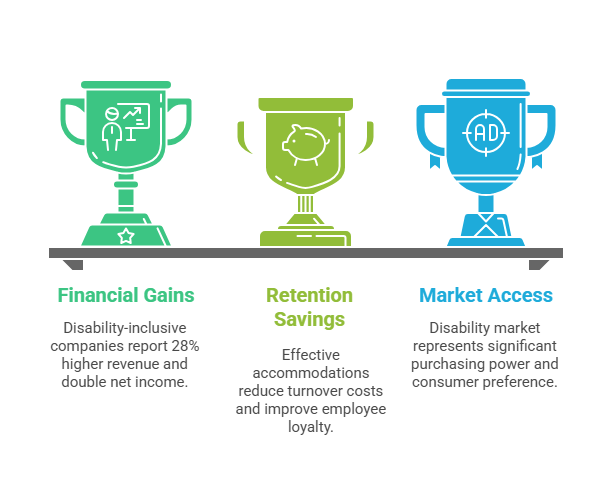
Organizations successfully reducing employment barriers experience measurable business benefits beyond legal compliance. Disability-inclusive companies report 28% higher revenue according to Accenture research. They show double net income and 30% higher profit margins. These outcomes result from expanded talent pools, enhanced innovation, improved engagement, and strengthened reputation among consumers preferring socially responsible businesses.
Retention improvements represent significant cost savings. Average replacement cost ranges from 50% to 200% of annual salary accounting for recruiting, training, and productivity losses. Employees with disabilities receiving appropriate accommodations demonstrate loyalty exceeding workforce averages. Job Accommodation Network reports effective accommodations help retain valuable employees and reduce turnover costs. Cultures normalizing accommodations benefit all employees.
Market and Reputation Advantages
Consumer preference increasingly favors businesses with demonstrated disability inclusion commitments. The disability market represents significant purchasing power. The 61 million Americans with disabilities control over $490 billion in disposable income annually. Including friends and family, this influence expands to over $8 trillion globally. Companies recognized for authentic inclusion access this market more effectively and build loyalty across diverse segments.
Innovation capabilities expand when teams include members with disabilities bringing alternative perspectives. Accommodations designed for employees with disabilities often benefit entire workforces. Flexible scheduling assists working parents. Ergonomic equipment reduces injuries. Clear communication protocols improve efficiency. The "curb cut effect" describes how disability-focused innovations create unexpected broader benefits, similar to how curb cuts designed for wheelchair users also help people with strollers or luggage.
Resources and Support for Employers
Job Accommodation Network (JAN) provides free, confidential guidance to employers navigating reasonable accommodations requirements. This service funded by the U.S. Department of Labor offers practical solutions, ADA compliance advice, and financial incentive information. JAN consultants help employers understand requests, identify cost-effective solutions, and implement effective processes. Their extensive database catalogs accommodations by disability type and job function.
Financial incentives and tax benefits offset accommodation costs. The Work Opportunity Tax Credit provides credits up to $9,600 for hiring individuals from targeted groups including people with disabilities referred from vocational rehabilitation. The Disabled Access Credit helps small businesses, offering credits up to $5,000 annually. The Architectural Barrier Removal Tax Deduction allows deductions up to $15,000 annually. State incentives and vocational rehabilitation support further reduce costs.
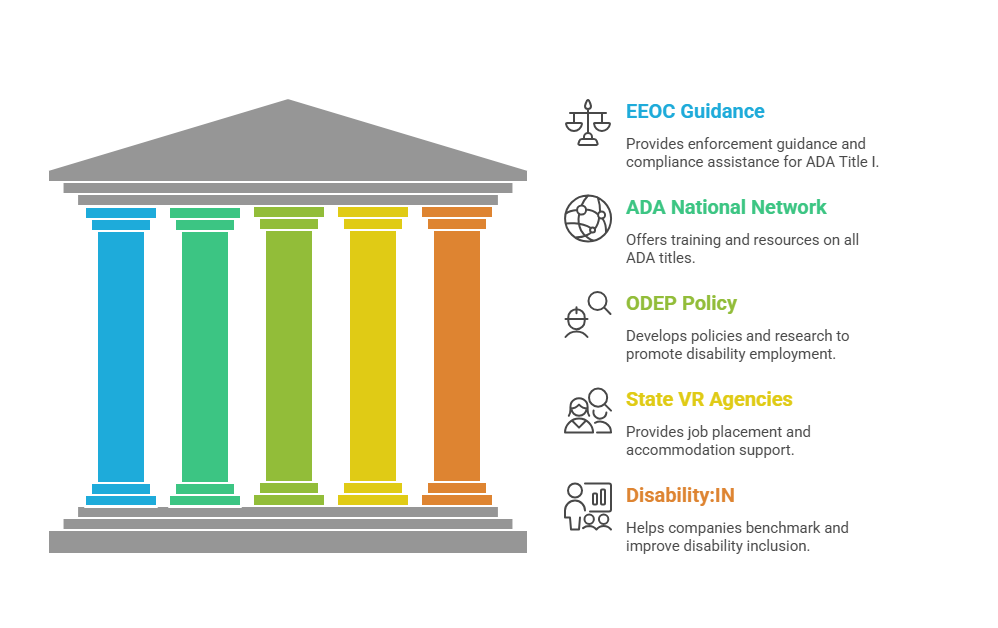
- Equal Employment Opportunity Commission (EEOC) offers enforcement guidance, compliance assistance, and technical assistance documents explaining ADA Title I requirements for employers
- ADA National Network operates regional centers providing training, technical assistance, and resources on all ADA titles including employment provisions
- Office of Disability Employment Policy (ODEP) provides research, policy development, and technical assistance promoting employment of people with disabilities
- State Vocational Rehabilitation Agencies provide job placement assistance, workplace assessment, accommodation consultation, and sometimes funding support for accommodations and training
- Disability:IN is a business-to-business network offering tools like the Disability Equality Index that help companies benchmark and improve disability inclusion practices
Vocational rehabilitation partnership models create structured pathways while providing ongoing support. State VR agencies assess skills, provide training, identify positions, and facilitate placements. Many offer on-the-job training programs covering partial wages during initial periods, reducing employer risk. VR counselors conduct workplace assessments and sometimes fund expensive technology. These partnerships benefit employers through access to pre-screened candidates and expert guidance.
Legal Compliance and Risk Management
EEOC enforcement has intensified recently. In fiscal year 2023, the EEOC received over 25,000 disability discrimination charges, recovering $134.7 million. Common violations include failure to provide accommodations, prohibited pre-offer medical questions, overly broad physical requirements, and retaliation. Proactive compliance costs significantly less than defending claims averaging over $100,000 in legal fees.
Documentation practices form the foundation of effective compliance. Employers should maintain detailed job descriptions identifying essential versus marginal functions developed before posting positions. When employees request accommodations, document the interactive process including communications, accommodations considered, and implementation details. Medical documentation requests should be specific, limited to establishing disability and accommodation needs. All disability information must be in confidential medical files with restricted access.
Policy development should reflect current requirements. Written accommodation procedures provide consistency while educating managers. Attendance policies should incorporate flexibility for disability-related absences. Leave policies should explain interaction between ADA and FMLA requirements. Anti-retaliation policies must explicitly protect employees requesting accommodations or filing complaints.
| Compliance Area | Key Requirement | Risk if Non-Compliant |
| Job Descriptions | Identify essential functions before hiring | Weak defense in accommodation disputes |
| Pre-Offer Inquiries | No medical questions or disability disclosure requests | Direct ADA violation resulting in claims |
| Interactive Process | Good-faith dialogue about accommodation needs | Failure to accommodate claims |
| Medical Documentation | Limited to establishing disability and need | Invasion of privacy claims |
| Confidentiality | Separate medical files with restricted access | Privacy violations and additional damages |
Training programs reduce compliance risks while improving outcomes. Training should cover recognizing accommodation requests, conducting compliant processes, and avoiding prohibited inquiries. Supervisor training deserves particular attention since frontline managers make daily decisions affecting employees. Regular refresher training keeps compliance top-of-mind as demographics and functions evolve.
Building a Culture of Disability Inclusion
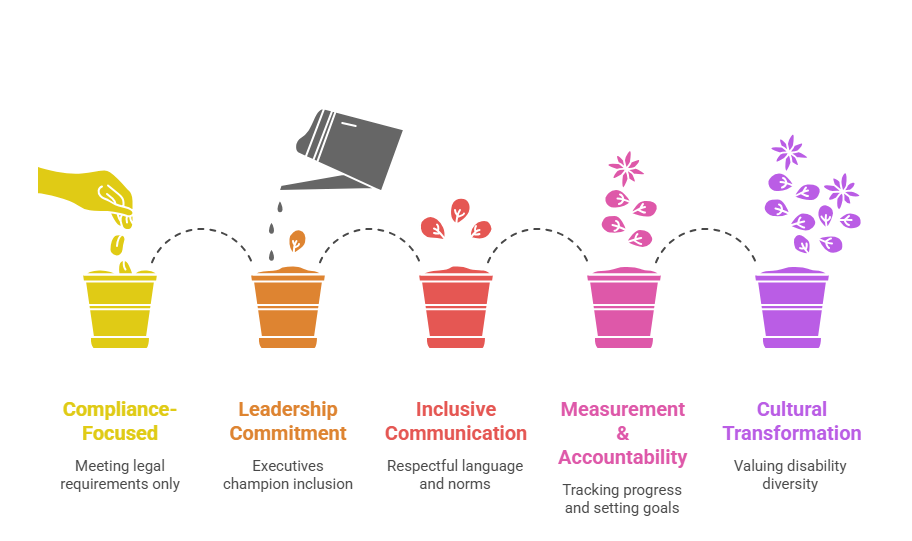
Creating inclusive workplaces requires more than compliance—it demands cultural transformation valuing disability diversity as competitive advantage. Leadership commitment serves as the foundation. When executives publicly champion inclusion and hold managers accountable, culture shifts. Employee resource groups provide peer support and valuable feedback shaping policies. Mentorship programs pairing employees with disabilities with senior leaders facilitate development and challenge stereotypes.
Inclusive language and communication norms signal organizational values. Using person-first language respects individual identity, though employers should recognize some prefer identity-first language. Respecting preferences matters most. Avoiding outdated terms demonstrates awareness. Training employees to focus on abilities rather than limitations shifts conversations. Normalizing accommodation discussions by framing them as productivity tools rather than special treatment reduces stigma.
Measurement and accountability drive sustained progress. Tracking disability representation across hiring, retention, promotion, and leadership reveals where barriers persist. Anonymous surveys assessing inclusion climate identify areas needing attention. Benchmarking tools like the Disability Equality Index provide external comparisons. Publishing diversity data demonstrates transparency. Setting specific goals and tying leadership compensation to progress ensures accountability. Organizations embedding disability inclusion into strategic planning achieve more substantial change.
Disability Disclosure and Privacy Considerations
Disability disclosure remains a deeply personal decision with significant professional implications. Employees must balance accommodation needs against discrimination fears. Disclosure timing varies based on circumstances and culture. Some disclose during applications when needing interview accommodations. Others wait until after offers when requesting modifications. Still others delay until establishing credibility. Employers cannot require disclosure but must respond appropriately.
Privacy protections strictly limit employer handling of disability information. Medical documentation must be kept in separate, locked files with access limited to legitimate need-to-know individuals. Supervisors should receive only information necessary for implementation, not diagnoses. Sharing with coworkers requires explicit employee permission. Confidentiality breaches can result in separate legal claims. Clear protocols protect both employees and employers.
Supporting Voluntary Disclosure
Employers can encourage disclosure by creating psychologically safe environments. Clear communication about accommodation processes reduces uncertainty. Providing multiple request channels including supervisor conversations, HR contacts, or hotlines offers flexibility. Sharing success stories demonstrates commitment. Leadership disclosure by executives sends powerful messages. However, employers must never pressure disclosure or penalize privacy choices. Decisions must remain entirely individual.
Self-identification campaigns for affirmative action differ from accommodation requests. These voluntary surveys help federal contractors meet Section 503 reporting requirements. They should clearly state responses are confidential, voluntary, and won't trigger employment action. Emphasizing aggregate data nature and explaining how it supports diversity initiatives encourages participation. Separating self-identification from accommodation processes ensures employees understand different purposes and protections.
Addressing Specific Disability Categories
Different disability categories present unique employment barriers requiring tailored solutions. Mobility impairments and physical disabilities benefit most from environmental modifications. Wheelchair-accessible workstations, adjustable desks, accessible parking, and barrier-free pathways address primary obstacles. Ergonomic equipment helps employees with arthritis or limited dexterity. Job restructuring reassigning physically demanding marginal tasks enables essential function focus. Remote work eliminates commuting challenges.
Sensory disabilities including vision and hearing impairments require technology and communication accommodations. Screen readers, magnification software, and Braille displays enable blind employees to access digital information. Sign language interpreters, real-time captioning, and visual alert systems support deaf employees. Ensuring all digital content meets WCAG standards benefits both groups. Training coworkers on disability etiquette improves interactions including facing people when speaking for lip reading or describing visual information.
Mental health conditions remain among the most stigmatized yet common workplace disabilities. Flexible schedules accommodate therapy appointments and medication adjustments. Quiet workspaces reduce sensory overload triggering anxiety. Regular check-ins provide structure for employees benefiting from routine. Clear written instructions help those experiencing concentration difficulties. Time off for mental health treatment should receive the same respect as physical health needs.
Small Business Considerations
Small businesses face unique challenges and opportunities in disability employment. With fewer resources and smaller teams, accommodations may seem burdensome. However, undue hardship standards account for business size. What's unreasonable for a 10-person company could be manageable for a 500-person organization. Small businesses often offer advantages including closer relationships, greater flexibility, and easier communication facilitating accommodation implementation.
Financial assistance programs specifically support small employers. The Small Business Tax Credit provides up to $5,000 annually. State vocational rehabilitation agencies often provide more generous accommodation funding for small businesses, recognizing limited resources shouldn't prevent disability hiring. They may cover equipment costs, modifications, and partial wages during training. JAN consultants help identify low-cost creative solutions.
Flexibility inherent in small business operations can actually ease accommodation provision. Less bureaucracy means faster decision-making. Fewer employees make job restructuring simpler. Close working relationships facilitate informal accommodations requiring formal policies in larger organizations. Small businesses embracing disability inclusion often find it strengthens team cohesion. Employees appreciate organizations valuing people over rigid policies, creating recruiting advantages against larger employers.
Conclusion
Employment barriers disabilities encompass physical, attitudinal, policy, and communication obstacles continuing to limit workforce participation despite decades of ADA protections. Addressing these barriers through comprehensive reasonable accommodations, inclusive hiring processes, and accessible workplaces creates opportunities for over 42 million working-age Americans with disabilities while delivering measurable business benefits including expanded talent pools, improved retention, enhanced innovation, and stronger market reputation. Employers viewing ADA compliance and disability inclusion as strategic advantages position themselves for success in competitive talent markets. The path forward requires ongoing commitment to removing barriers and creating cultures where all employees contribute their full talents.
Frequently Asked Questions
What are the most common employment barriers faced by people with disabilities?
The most common employment barriers include physical accessibility issues like inaccessible buildings, attitudinal barriers such as unconscious bias, and communication obstacles for deaf and blind workers. Inflexible workplace policies, lack of accessible transportation, inadequate assistive technology, and policy structures like benefits cliffs also create significant barriers that often intersect, preventing qualified individuals from accessing employment.
What reasonable accommodations must employers provide under the ADA?
Employers must provide reasonable accommodations enabling qualified individuals to perform essential job functions unless causing undue hardship. Common accommodations include flexible schedules, telework arrangements, ergonomic furniture, and assistive technology such as screen readers. Job restructuring, providing interpreters, allowing service animals, and modified policies including additional unpaid leave are also common accommodations.
When can employers ask about disabilities during the hiring process?
ADA compliance prohibits disability-related inquiries and medical examinations before extending conditional job offers. During applications and interviews, employers can only ask about ability to perform specific job functions. After conditional offers but before employment begins, employers may conduct medical exams if all entering employees in that category undergo the same process.
What is undue hardship and when can employers deny accommodations?
Undue hardship refers to significant difficulty or expense relative to employer size, financial resources, and operations. Employers can deny accommodations only by demonstrating specific modifications would impose undue hardship through individualized assessment. Factors include accommodation cost, overall budget, employee numbers, and operational impact. Employers cannot claim undue hardship based on coworker complaints or speculative costs.
How much do workplace accommodations typically cost?
Job Accommodation Network research shows 56% of accommodations cost nothing, while typical expenditure is only $500. Low-cost accommodations include schedule flexibility, remote work arrangements, and written instructions supplementing verbal communications. Even equipment purchases like ergonomic furniture or assistive technology rarely exceed a few thousand dollars, with tax credits further reducing net costs.
What is the interactive process for determining accommodations?
The interactive process is ongoing dialogue between employers and employees identifying effective accommodations. It begins when employees disclose disabilities and request accommodations, though formal terminology isn't required. Employers should ask clarifying questions about limitations, discuss potential accommodations, consider effectiveness and preference among options, and implement accommodations promptly with follow-up ensuring effectiveness.
How do ADA requirements interact with background checks?
Background checks must be conducted in ADA-compliant ways avoiding discrimination. Employers cannot ask about disabilities, workers' compensation history, or sick leave during investigations. Medical examinations are prohibited until after conditional offers. When criminal checks reveal conviction records, particularly for offenses potentially related to mental health or substance use disabilities, EEOC guidance requires individualized assessment rather than blanket exclusions.
What resources help employers implement disability-inclusive hiring practices?
Job Accommodation Network provides free guidance on accommodations and compliance. State vocational rehabilitation agencies offer candidate referrals, workplace assessments, and sometimes accommodation funding. The EEOC provides technical assistance while the ADA National Network operates regional centers offering training. Disability
offers the Disability Equality Index, and tax incentives including the Work Opportunity Tax Credit offset hiring costs.
What are the business benefits of hiring employees with disabilities?
Businesses implementing disability-inclusive hiring experience expanded talent pools, improved retention rates as employees demonstrate strong loyalty when provided appropriate accommodations, and enhanced innovation from diverse perspectives. They benefit from strengthened reputation among consumers preferring socially responsible businesses and improved financial performance, with research showing disability-inclusive companies achieve 28% higher revenue and double the net income.
Additional Resources
- Job Accommodation Network (JAN) – Guidance on Workplace Accommodations
https://askjan.org/ - EEOC – The ADA: Your Employment Rights as an Individual With a Disability
https://www.eeoc.gov/laws/guidance/ada-your-employment-rights-individual-disability - ADA National Network – Employment Resources and Technical Assistance
https://adata.org/employment - U.S. Department of Labor Office of Disability Employment Policy
https://www.dol.gov/agencies/odep - Disability:IN – Disability Equality Index and Employer Resources
https://disabilityin.org/ - Social Security Administration – Ticket to Work Program
https://www.ssa.gov/work/ - Partnership on Employment & Accessible Technology (PEAT)
https://www.peatworks.org/
Still have questions?
Get in touch with our team today for a personalized demo and discover how our tailored volume pricing and packages can drive results for your business!
How useful was this page?*
Note: your comments are anonymous. We use them to improve the website. Do not include any personal details.
Visit our FCRA Compliance Tool or leave a message here if you need a response.
From the blog Explore the GCheck Content Hub

How Long Does a Background Check Take? A Complete 2025 Guide
13 Dec, 2023 • 14 min read
The Ultimate Background Check Guide
13 Dec, 2023 • 4 min read
The Ultimate Guide to Employment Background Checks
13 Dec, 2023 • 10 min readThe information provided in this article is for general informational and educational purposes only and should not be construed as legal advice or a substitute for consultation with qualified legal counsel. While we strive to ensure accuracy, employment screening laws and regulations—including but not limited to the Fair Credit Reporting Act (FCRA), Equal Employment Opportunity Commission (EEOC) guidelines, state and local ban-the-box laws, industry-specific requirements, and other applicable federal, state, and local statutes—are subject to frequent changes, varying interpretations, and jurisdiction-specific applications that may affect their implementation in your organization. Employers and screening decision-makers are solely responsible for ensuring their background check policies, procedures, and practices comply with all applicable laws and regulations relevant to their specific industry, location, and circumstances. We strongly recommend consulting with qualified employment law attorneys and compliance professionals before making hiring, tenant screening, or other decisions based on background check information.

